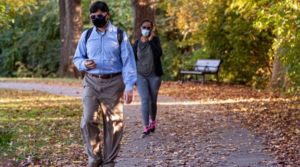Written by Libby White, PT, DPT
The year 2020 has presented many individuals with challenging circumstances, whether fiscal, psychological, or physical. My observation of individuals through the scope of physical therapy is that we are resilient and adaptable, but that we are all being challenged by COVID-19. Many of the clients I treat are living with movement disorders and experience balance difficulties, and it did not take long to determine through observation and subjective report that wearing a mask has had an impact on their balance and walking.
The Center for Disease Control (CDC) recommends that people wear masks in public settings such as public and mass transportation, at events and gatherings, and anywhere they will be within six feet of other people. (1) The recommendation to wear a mask is based on the known role of respiratory droplets in the spread of the virus. (1)
how masks impact your field of vision and balance
The maintenance of upright stance and balance requires the dynamic interaction of multiple motor sensory processes (visual, vestibular, proprioception) to generate coordinated movements that maintain the center of mass within limits of stability. (2) Partial visual field impairments are notable with some styles of masks, and more significant visual field impairments are possible if the individual wears glasses.
As my clients were adapting to a new normal with the onset of COVID, many noted increased gait and balance challenges due to wearing a mask. Some reported conscious awareness, while others demonstrated objective or subjective unconscious impacts of the mask on mobility.
Unfortunately, three of my clients sustained falls that they primarily attributed to mask wearing with lower visual field cuts. One person with Parkinsonism fell while on a walk with his wife. He reported a reduced postural response after losing his balance when he did not see the edge of the pavement while walking downhill. Before the fall, he (who walks every day for 30 minutes) had not sustained a fall in more than a year.
Another client with Parkinsonism slipped on a patch of ice prior to ascending a curb. He was anticipating the step up onto the curb and did not see the patch of ice; he attributed his misstep directly to the deficit of his lower visual field.
The third client, who has spinocerebellar ataxia, suspects that wearing a mask contributed to her fall as well, which occurred as she was walking down a trail in the mountains on uneven terrain. Since then, she has reduced her outdoor activity level substantially because of the increased difficulty with balance and gait she experiences when wearing a mask outdoors.
 the observational study
the observational study
These three clients caused me to evaluate a set of normal controls. The aim of this observational study was to propose a correlation between reduced visual field information due to mask wearing and a potential increase in fall risk in individuals with movement disorders, balance, and mobility deficits.
Five healthy control subjects (n=5) were selected at random to evaluate visual field impairments imposed by a mask. Ages ranged from 32-65 years, and height was not taken into consideration in this study. All participants used a standard paper mask with wiring for the nose that was adjusted by the participants themselves. Measurements were taken without allowing the participant to perform neck flexion in order to look down.
A dowel was placed on level ground, moved progressively closer to the individuals, and each person was asked to indicate at what distance they could no longer see the object. The average distance from toes to dowel before the mask was applied measured 60 inches. With a mask in place, the average distance from the toes of participants was 42 inches. This represents a 30% reduction in visual field, which could readily explain an increase in falls represented by my clients. It should be noted that level ground does not account for angles, such as on descending hills or stairs, which would increase that distance; thus, the visual field cut would be greater on descending surfaces.
 how to stay safe while wearing a mask
how to stay safe while wearing a mask
In summary, this case report highlights an unforeseen negative effect of wearing a mask on balance in people with movement disorders and balance impairments. While masks remain critical for slowing the spread of the novel coronavirus, it’s important that people living with Parkinson’s who have difficulty with balance are aware of the impact wearing a mask can have on their lower visual field.
Remember, when you are wearing a mask:
- Know that your field of vision will be reduced
- Choose a mask that allows you to adjust its placement on your nose and cheeks to minimize visual impairment
- Slow your pace while walking or exercising while wearing a mask
- Actively look down (more often than you normally would) to be sure you are aware of any obstacles, unanticipated steps, or slopes
- If you are concerned about falls while wearing a mask and exercising, ask a friend to join you for your workout, or explore at-home routines that will allow you to move without needing to wear a mask
References
- National Center for Immunization and Respiratory Diseases (NCIRD), Division of Viral Diseases. Center for Disease Control. (2020, November). Use Masks to Help Slow the Spread of COVID-19. Retrieved from: https://www.cdc.gov/coronavirus/2019-ncov/prevent-getting-sick/diy-cloth-face-coverings.html.
- Miller L, McFayden A, Lord A.C., et al. Functional Electrical Stimulation for Foot Drop in Multiple Sclerosis: A Systematic Review and Meta-Analysis of the Effect on Gait Speed. Archives of Physical Medicine and Rehabilitation. 2017; 98:1435-52.
learn how physical therapy can help you live well with Parkinson’s
Libby White of Physical Therapy of Boulder is currently seeing clients through telehealth. To learn more, visit ptofboulder.com.
6 Surprising Things a Parkinson’s Physical Therapist Can Help You Improve
Physical Therapy and Parkinson’s Panel
Ask the Parkinson’s Expert: Physical Therapy with Dr. Sarah King
Parkinson’s Physical Therapy: A Panel of Experts Weighs in on Why You Need It





